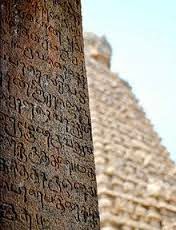Indian languages are divided into various language families - Indo-Aryan languages, the Ironic languages, the Dravidian languages and Tibeto-Burmese spoken by smaller groups. Linguistic records in the form of the Brāhmī script go back to about the 3rd century BCE.
 |
| Sanskrit. vedas trinetra.org.uk |
Sanskrit's first written record can be found in the Rig-Veda (c. 1500 BCE). It is divided into two general categories - the more ancient Vedic Sanskrit (approximately 1500–200 BCE) and Classical Sanskrit (approximately 500 BCE–1000 CE).
Used primarily for religious and ceremonial purposes in modern India, Sanskrit is one of the country's 23 official languages (which includes English). The great Indian epics, the Ramayana and the Mahabharata (c. 400 BCE), it is believed, was written between 400 BCE and 100 BCE. Like Latin in the medieval West, Sanskrit was a scholarly language 200 CE and 1000 CE in ancient south Asia.
Agattiyam is the oldest work in Tamil which was written around 300-350 BC- in Sangam era. Sangam literature, is dated from ca. 300 BC – AD 300. It has the oldest literature among other Dravidian languages.The oldest dated Tamil inscription written in the Tamil-Brahmi script was found in Palani in Southern India, scientifically dated to 540 BCE -
In Egypt, Sri Lanka and Thailand there are Tamil inscriptions dating back to first and second century.
Agattiyam was written by Agasthiya,r who was one of the Saptha Rishis(Sages) mentioned in the vedas. He is also the author of Agathiya Samhita (Written in Sanskrit). The oldest author of Tamil is also the author of a Sanskrit work and also has a Sanskritic name. As a matter of fact, in the olden days many Tamil scholars had mastery over both Sanskrit and Tamil and they never encouraged linguistic chauvinism as prevalent to day in south India. They were not only great scholars in languages but also had an unalloyed passion for them without being zealots.
The Vedas (sacred knowledge - 500 BCE and 600 BCE) are Hinduism's oldest and most sacred texts, compiled by Vyasa Krishna Dwaipayana and are collections of hymns and ritual instructions used to perform Vedic ceremonies. The theology and philosophy they contain form the very basic foundation of the indigenous religious systems of India which we call ''Hinduism.''
The four works are - the Rig-Veda - oldest collection of over 1,000 hymns, invoking the deities Indra and Agni, the gods of war and fire, respectively. Atharva-Veda, a collection of myths, verses, spells, and prayers ; the Yajur-Veda a collection on Vedic sacrifice; and finally the Sama-Veda, a collection of liturgical chants.
 |
| Tamil inscription inThailand. tamilnatiom.com |
Among the languages in the Indian subcontinent, Tamil (c 200 BC), a Dravidian language of Southern India, though enriched by Sanskrit has less Sanskritic words than other South Indian languages. Telugu, Kannada and Malayalam have their roots in Tamil but have more Sanskritic words.
Many people may not be aware that Tamil was the first among the Indian languages to be printed and published. Thanks to Portuguese Christian Missionaries who were responsible for printing and publishing of prayer book in old Tamil script named 'Thambiraan Vanakkam' (1578). Tamil, also a sacred language of Ayyavazhi and in Tamil Hindu traditions of Shaivism and Vaishnavism. There were 1,863 newspapers published in Tamil, of which 353 were dailies.(2001).
From the period of the Pallava dynasty onwards, a number of Sanskrit loan-words entered Tamil, particularly in relation to political, religious and philosophical concepts. Sanskrit also influenced Tamil grammar, in the increased use of cases and in declined nouns becoming adjuncts of verbs,and phonology. Almost all Indian languages are rich in beautiful literature - prose, poetry and epics and have well defined syntax and grammar. Middle Indo - Aryan - Prakrit dates back to c 400BC.
The Dravidian family of languages includes approximately 73 languages that are mainly spoken in south India and northeastern Sri Lanka, as well as certain areas in Pakistan, Nepal, Bangladesh, and eastern and central India, as well as in parts of Afghanistan and Iran.The earliest long text in 'Old Tamil' is the Tolkāppiyam, an early work on Tamil grammar and poetics (1st century BCE).
Tamil is one of the longest surviving classical languages in the world - example 2,200-year-old Tamil-Brahmi inscriptions on Samanamalai and "one of the great classical traditions and literatures of the world" According to Archaeological society of India roughly 55,000 epigraphical inscriptions on rock dating back from 3rdC are in Tamil.Much of Tamil grammar is extensively described in the oldest known grammar book for Tamil, the Tolkāppiyam. Modern Tamil writing is largely based on the 13th century grammar ''Naṉṉūl'' which restated and clarified the rules of the Tolkāppiyam
 |
| Tamil stone inscription,Big temple Thanjavur,TamilNadu,India |
The Dravidian languages form a close-knit family – much more closely related than, say, the Indo - European languages. There is a reasonable agreement on how they are related to each other. There are tens of thousands of Tamil hymns – expressive soul stirring devotional songs sung by Nayanmars and Alvazars glorifying Lord Shiva and Lord Vishnu respectively. The practice of singing these ancient mystic devotional hymns is in vogue in many temples of Tamil Nadu. Kambar Ramayanam and Sri Villiputurar Bharatam were translated from Sanskrit works several centuries ago.
Among the southern languages, Malayalam has assimilated the largest number of Sanskrit words. In the case of time honored tradition-rich Carnatic music, the intricate, rich compositions are mostly in Telugu, which Bharatiyar described as 'a beautiful musical language.'Likewise the literary works in Kannada are vast.
Ref:
wikipedia.org/wiki/Linguistic_history_of_the_Indian_subcontinent
Aiyar, Swaminatha (1987). Dravidian theories. p. 286. ISBN 978-81-208-0331-2. Retrieved 22 January 2014.
A family tree of Dravidian languages. Sourced from Encyclopaedia Britannica.
Meenakshisundaram, T. P. A History of Tamil Language, Sarvodaya Ilakkiya Pannai, 1982. (translated) p. 241-2Masica, Colin (1991).
The Indo-Aryan languages. Cambridge New York: Cambridge University Press. pp. 36 – 38. ISBN 0-521-23420-4.http://en.wikipedia.org/wiki/sa.
(Reedited: Feb. 24, 2015)

.jfif)


.jfif)

.jpg)


